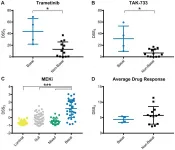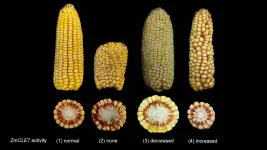(Press-News.org) Oncotarget recently published in "MEK is a promising target in the basal subtype of bladder cancer" by Merrill, et al. which reported that while many resources exist for the drug screening of bladder cancer cell lines in 2D culture, it is widely recognized that screening in 3D culture is more representative of in vivo response.
To address the need for 3D drug screening of bladder cancer cell lines, the authors screened 17 bladder cancer cell lines using a library of 652 investigational small-molecules and 3 clinically relevant drug combinations in 3D cell culture.
Their goal was to identify compounds and classes of compounds with efficacy in bladder cancer.
Utilizing established genomic and transcriptomic data for these bladder cancer cell lines, they correlated the genomic molecular parameters with drug response, to identify potentially novel groups of tumors that are vulnerable to specific drugs or classes of drugs.
Importantly, the Oncotarget authors demonstrate that MEK inhibitors are a promising targeted therapy for the basal subtype of bladder cancer, and their data indicate that drug screening of 3D cultures provides an important resource for hypothesis generation.
"The Oncotarget authors demonstrate that MEK inhibitors are a promising targeted therapy for the basal subtype of bladder cancer, and their data indicate that drug screening of 3D cultures provides an important resource for hypothesis generation"
Dr. Matthew B. Soellner and Dr. Sofia D. Merajver from The University of Michigan said, "Bladder cancer is the most frequent cancer of the urinary system in the United States with nearly 82,000 new cases each year and 18,000 deaths, affecting men more often, in a 3:1 ratio."
Bladder cancer can be divided broadly into non-muscle-invasive bladder cancer and muscle-invasive bladder cancer.
The Genomics of Drug Sensitivity in Cancer represents one of the largest efforts in total drugs, screening 19 bladder cancer cell lines against 518 drugs.
Indeed, screening in 3D using ultra-low attachment plates is ideal for bladder cancer cell culture, and this method has been utilized in seminal studies for screening patient-derived organoids to predict patient response to drug treatments.
Therefore, there is a utility in screening bladder cancer cell lines in large drug screens in 3D cultures to identify novel therapeutic options for future testing in PDOs and, ultimately, patients.
Then, utilizing established genomic and transcriptomic data for these bladder cancer cell lines, including prioritized mutations, copy number variants, and RNA-based molecular subtyping, they correlated these molecular parameters with drug response identifying potentially novel groups of tumors that are vulnerable to specific drugs or classes of drugs.
The Soellner/Merajver Research Team concluded in their Oncotarget Research Paper, "this work is a valuable resource for the identification of experimental therapeutics in bladder cancer, having screened 652 investigational therapeutics and 3 drug combinations in 17 bladder cancer cell lines, using a 3D cell culture format. As next steps, we pose that this work be used to further test additional therapeutic options for patients with bladder cancer. Moreover, this work highlights a need for biomarkers of drug response, beyond mutational data. Lastly, using these methods, we identify MEK inhibitors as a promising therapeutic in the basal bladder cancer subtype. Important future work will investigate the specific molecular features of the basal subtype that make these cells more sensitive to MEK inhibition, and if this MEK sensitivity signature is applicable to other cancer subtypes."
Sign up for free Altmetric alerts about this article
DOI - https://doi.org/10.18632/oncotarget.27767
Full text - https://www.oncotarget.com/article/27767/text/
Correspondence to - Matthew B. Soellner - soellner@umich.edu and Sofia D. Merajver - smerajve@med.umich.edu
Keywords -
bladder cancer,
drug screen,
3D culture,
basal bladder cancer,
MEK inhibition
About Oncotarget
Oncotarget is a biweekly, peer-reviewed, open access biomedical journal covering research on all aspects of oncology.
To learn more about Oncotarget, please visit https://www.oncotarget.com or connect with:
SoundCloud - https://soundcloud.com/oncotarget
Facebook - https://www.facebook.com/Oncotarget/
Twitter - https://twitter.com/oncotarget
LinkedIn - https://www.linkedin.com/company/oncotarget
Pinterest - https://www.pinterest.com/oncotarget/
Reddit - https://www.reddit.com/user/Oncotarget/
Oncotarget is published by Impact Journals, LLC please visit http://www.ImpactJournals.com or connect with @ImpactJrnls
An international team of scientists, including two from Oregon State University, conducted a biological assessment of the world's rivers and the limited data they found presents a fairly bleak picture.
"For the places that we have data, the situations are not really that good. There are many species that are declining, threatened or endangered," said Bob Hughes, co-author of the paper and a courtesy associate professor in Oregon State's Department of Fisheries and Wildlife. "But for most of the globe, there just is little rigorous data."
The work by Hughes and the ...
By analyzing 50 years' worth of coral reef biodiversity studies, researchers reporting in the journal Current Biology on February 22 have quantified the practice of "parachute science," which happens when international scientists, typically from higher-income countries, conduct field studies in another, typically lower-income country, without engaging with local researchers. They found that institutions from several lower-middle- and upper-middle-income countries with abundant coral reefs produced less research than institutions based in high-income countries with fewer or in some cases no reefs. They also found that host-nation scientists (scientists from the nations where field research was conducted) were ...
Corn--or maize--has changed over thousands of years from weedy plants that make ears with less than a dozen kernels to the cobs packed with hundreds of juicy kernels that we see on farms today. Powerful DNA-editing techniques such as CRISPR can speed up that process. Cold Spring Harbor Laboratory (CSHL) Professor David Jackson and his postdoctoral fellow Lei Liu collaborated with University of Massachusetts Amherst Associate Professor Madelaine Bartlett to use this highly specific technique to tinker with corn kernel numbers. Jackson's lab is one of the first to apply CRISPR to corn's very complex ...
Tracing back a ghostly particle to a shredded star, scientists have uncovered a gigantic cosmic particle accelerator. The subatomic particle, called a neutrino, was hurled towards Earth after the doomed star came too close to the supermassive black hole at the centre of its home galaxy and was ripped apart by the black hole's colossal gravity. It is the first particle that can be traced back to such a 'tidal disruption event' (TDE) and provides evidence that these little understood cosmic catastrophes can be powerful natural particle accelerators, as the team led by DESY scientist Robert Stein reports in the journal Nature Astronomy. The observations also demonstrate the power of exploring the cosmos via ...
A new study from UCLA and Stanford University researchers finds that three-dimensional human stem cell-derived 'mini brain' organoids can mature in a manner that is strikingly similar to human brain development.
For the new study, published in Nature Neuroscience February 22, senior authors Dr. Daniel Geschwind of UCLA and Dr. Sergiu Pasca of Stanford University conducted extensive genetic analysis of organoids that had been grown for up to 20 months in a lab dish. They found that these 3D organoids follow an internal clock that guides their maturation in sync with the timeline of human development.
"This is novel -- Until now, nobody has grown and characterized these organoids for this amount of time, nor shown they will recapitulate human brain development in a laboratory environment ...
A two-metre-long painting of a kangaroo in Western Australia's Kimberley region has been identified as Australia's oldest intact rock painting.
Using the radiocarbon dating of 27 mud wasp nests, collected from over and under 16 similar paintings, a University of Melbourne collaboration has put the painting at 17,500 and 17,100 years old.
"This makes the painting Australia's oldest known in-situ painting," said Postdoctoral Researcher Dr Damien Finch who pioneered the exciting new radiocarbon technique.
"This is a significant find as through these initial estimates, we can understand something of the ...
What The Study Did: Using COVID-19 data, this observational study looked at what are the independent associations of voluntary behavioral change and legal restrictions, such as state-mandated school closings, with the subsequent spread of the COVID-19 pandemic in the U.S.
Authors: Frederick J. Zimmerman, Ph.D., of the Fielding School of Public Health at UCLA in Los Angeles, is the corresponding author.
To access the embargoed study: Visit our For The Media website at this link https://media.jamanetwork.com/
(doi:10.1001/jamapediatrics.2020.6371)
Editor's Note: The article includes ...
A team of scientists has detected the presence of a high-energy neutrino--a particularly elusive particle--in the wake of a star's destruction as it is consumed by a black hole. This discovery, reported in the journal Nature Astronomy, sheds new light on the origins of Ultrahigh Energy Cosmic Rays--the highest energy particles in the Universe.
The work, which included researchers from more than two dozen institutions, including New York University and Germany's DESY research center, focused on neutrinos--subatomic particles that are produced on Earth only in powerful ...
What The Study Did: Researchers examined changes in trauma admissions throughout Los Angeles County during the COVID-19 pandemic in California.
Authors: Kazuhide Matsushima, M.D., of the University of Southern California in Los Angeles, is the corresponding author.
To access the embargoed study: Visit our For The Media website at this link https://media.jamanetwork.com/
(doi:10.1001/jamanetworkopen.2021.1320)
Editor's Note: The article includes funding/support disclosures. Please see the article for additional information, including other authors, author contributions and affiliations, conflict of interest and financial disclosures, ...
Scientists at the University of Groningen (The Netherlands), in collaboration with colleagues from the University of Torino (Italy), have developed a method to visualize and quantify alternative structures of RNA molecules. These alternative RNA 'shapes' can have important functional relevance in viruses and bacteria. The researchers used an algorithm to rapidly analyse large quantities of chemically modified RNA molecules and calculate how many differently folded conformations were present. This technique was used to identify a conserved structural switch in the ...





